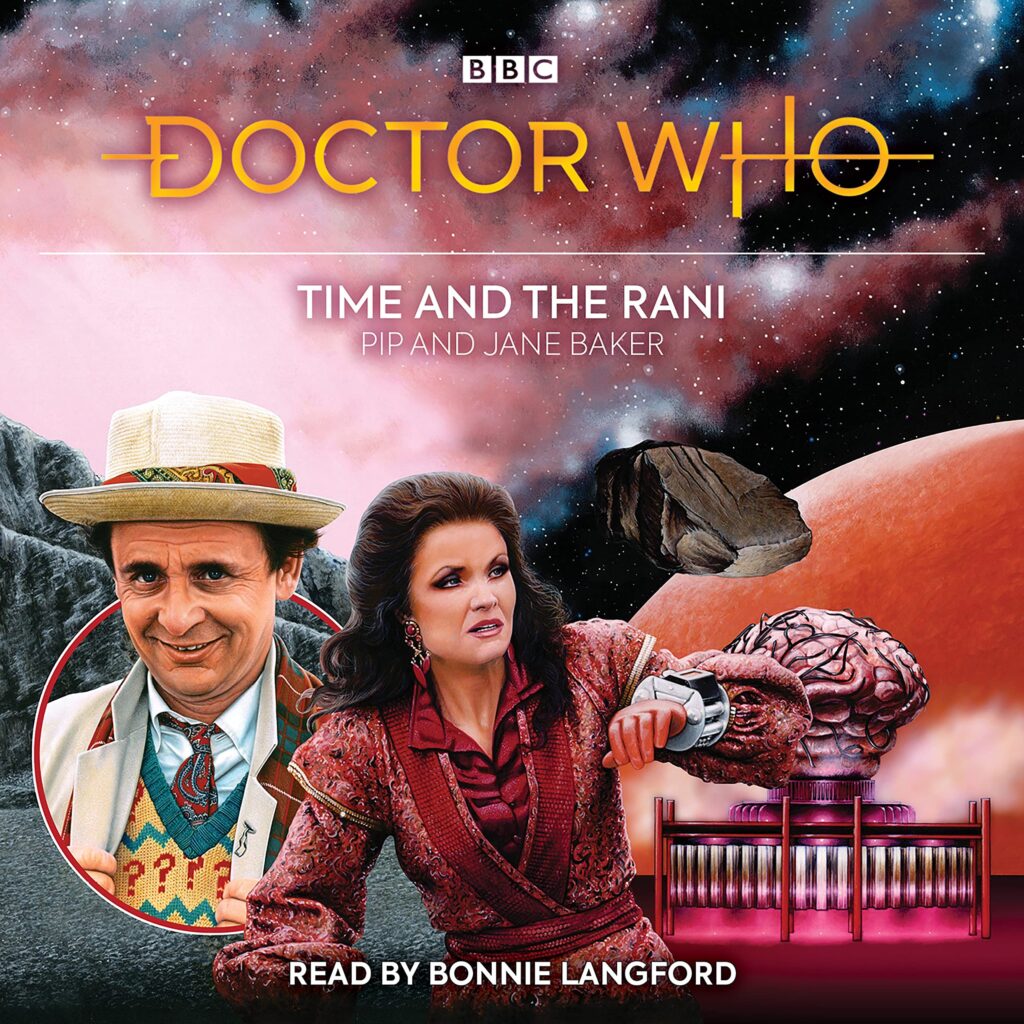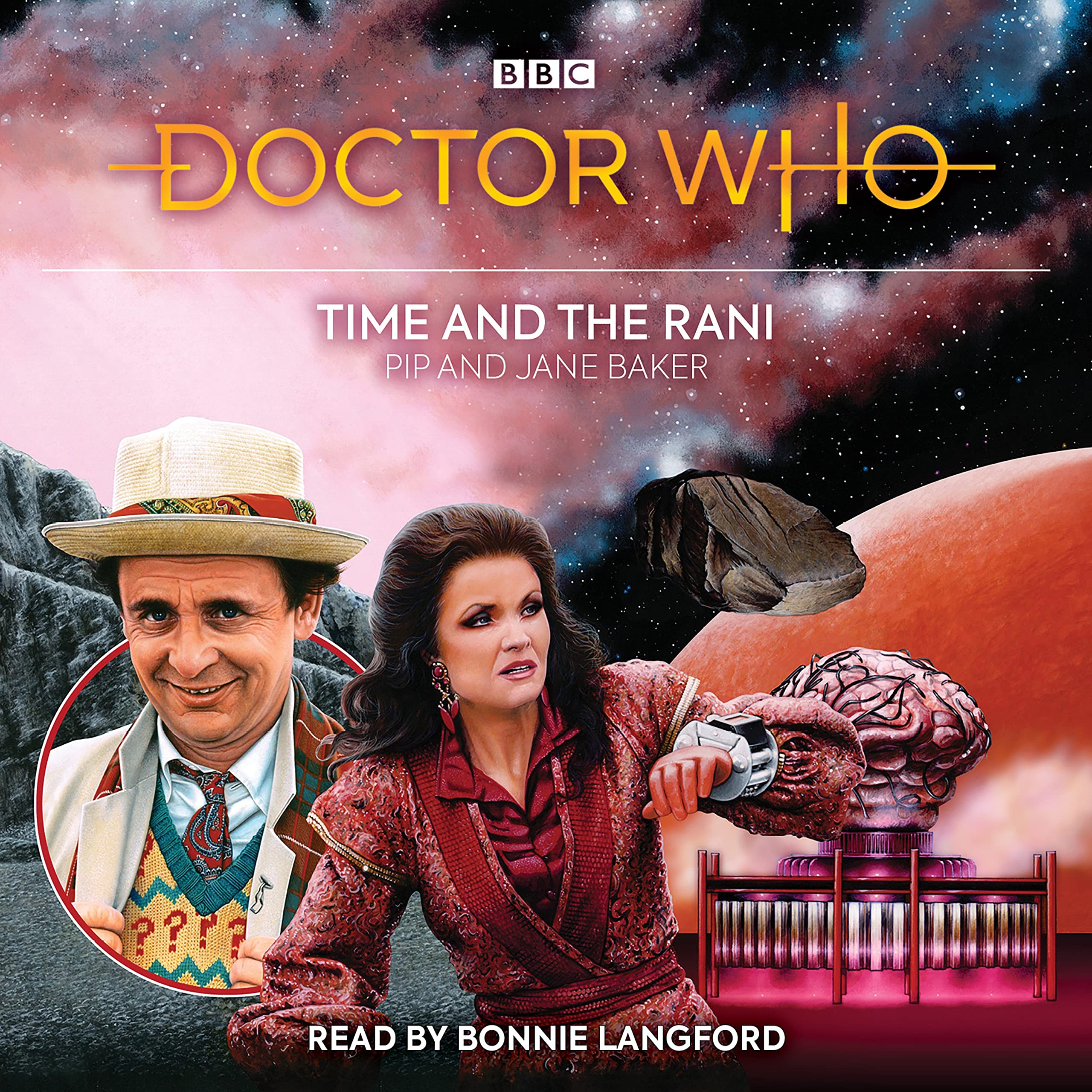
Time and the Rani is a story that suffered from several pitfalls on-screen.
For one thing, it was a regeneration story in which the outgoing Doctor-actor refused to film his half of the process, on the entirely reasonable grounds that he’d been fired from the role.
For another, Sylvester McCoy’s new Doctor spends much of the story with an enforced post-regenerative amnesia, spouting mangled and Spoonerised proverbs, and for at least some of the adventure, being snappy and confused.
And for a third thing, the main ‘monsters,’ bat-like creatures called Tetraps, were a strange combination of ‘obviously-men-in-suits’ and sculpted heads that didn’t allow for articulation beyond swivelling eyes and an extendable tongue. For bat-like creatures, they spent a great deal of their time in the story trudging around, threating the natives of Lakertya, the planet where the Rani has established her base, and in a fairly obvious vampire-parody, feeding on a plasma-based raspberry jam.
But the thing which hampered the story most of all is that it could never serve to do anything but diminish the Rani.
The Rani?
For those just joining us, the Rani was a masterpiece creation of experienced screenwriters Pip and Jane Baker. She was a renegade Time Lord scientist who wasn’t particularly evil as such, just cursed with a scientist’s pure amorality when it came to her experiments. An old academy acquaintance of both the Doctor and the Master, she was utterly above what she considered to be their petty squabbles back and forth across the space-time vortex.
She’d been introduced in the Sixth Doctor story, The Mark of the Rani, and in it, she had absolutely been the better of both the Doctor and the Master. It was only the inclusion of the Master in that story that had ultimately made her fail. It was his ego, his obsession with the Doctor, that ultimately led to her defeat.
So by bringing her back for Sylvester McCoy’s first story, and not giving her a suitable fall guy to take responsibility for the failure of her plans, that failure had to be the direct result of the Doctor’s cleverness – and her own ultimate foolishness. That meant Time and the Rani was always going to feel like less of a Rani story than The Mark of the Rani had, because this time she had to be defeated in a one to one battle with her old university colleague.
It also didn’t help that for much of the story, the Rani, played by supervamp Kate O’Mara, decided she had to pretend to the newly-regenerated Doctor that she was actually his companion, Melanie Bush, usually played by the professionally effervescent Bonnie Langford.
Viewers, both at the time and in the intervening 35 years, could therefore be forgiven for missing some of the really good things in Time and the Rani and focusing mostly on the what-the-hell-am-I-watching elements of the story that introduces the Seventh Doctor to the universe.
Now, those (did we mention) three and a half decades later, the original Target novelization, also by Pip and Jane Baker, has come to audiobook. The question is what it brings to the table, and whether it’s as good or better than the version that was shown on TV.
Yyyyyyep. Significantly better.
Here’s why.
Pip and Jane Baker were, above all, very logical writers.
Which is not something that necessarily came through in the on-screen version of Time and the Rani. From the fact that the Rani, an entirely brilliant chemist with the universe’s geniuses at her disposal, willingly tried to recruit her meddlesome classmate to help her with an amoral project, to her use of a ray gun that forces the Tardis off course (something she specifically threw scorn at the Master for doing in The Mark of the Rani), especially in such a way that it risked landing her with a regeneratively unstable Doctor.
There’s very little on-screen reason why, having administered the Doctor a drug to make him amnesiac, she couldn’t have tailored it so that he thought she was Mel without having to go to the extent of dressing up in a redheaded wig and adopt a squeaky voice to help sell the illusion.
The on-screen version doesn’t, for that matter, even explain how the Rani comes to be on Lakertya planning to build a time manipulator and re-order creation along more rational lines (Oops – spoilers, but then it has been 35 years), when she was last seen on screen at the end of The Mark of the Rani being both crushed by G-force in her Tardis, and menaced by a rapidly growing Tyrannosaurus Rex.
The novelization of Time and the Rani deals with a lot of these elements, and deals with them rationally, in satisfying ways that, when you listen to it, make you go “Ohhhh – well, now I get it!”. We could tell you the way she got out of the Tyrannosaurus Rex thing right here, right now, without spoiling anything about the actual storyline of Time and the Rani.
…
……
We’re not going to tell you that, obviously – it’s one of many hooks that separate the audiobook from the TV version, which means it’s one of the things that makes the audiobook worth buying for yourself.
We’re making the point simply to show there are jewels of logic in the novelization that join the dots that remained unjoined in the televised version, so it’s a much more complete-feeling, rationally told Doctor Who story than it’s ever done before.
The story of the Rani’s subjection of the reptilian humanoid Lakertyans, her use of the Tetraps as a military force to keep order among an already apathetic populace, and her ultimate project to feed an enormous brain with the genius of minds pilfered from all around the universe of time and space (rather than just from the history of Earth, as was shown on-screen – an always peculiar thing, given that on the whole, the Rani’s attitude to humanity was that they were ants under her feet), makes a lot more sense in the novelization.
That she’s using the giant brain to crack an ultimate scientific conundrum – how to create a lightweight substance to explode an asteroid of something called Strange Matter, an incredibly dense material usually only explodable…by itself – is also clear, though the wheels begin to come off the logic when you realise she’s a Time Lord and could surely have just popped forward to a point when someone else had made the discovery and then stolen it from them. We can presumably put it down to a combination of Time Lord arrogance and scientific self-aggrandisement.
Her ultimate goal for the combination of the big brain and the exploded Strange Matter is frankly barking, but it’s frankly barking in a very plausible Doctor Who way that at least makes sense within the context of gigantic scientific ambition.
What still never entirely makes sense is why the Rani, always regarded even by herself as a right old cleverclogs, would create a scheme at any point of which she would need the assistance of the Doctor.
That’s just never going to work in her favour, and it feels like a manufactured problem in the initial script – although without it, we wouldn’t have Sylvester McCoy’s Doctor as we initially knew him, and the whole point of Time and the Rani would evaporate in an instant, so what do you say we let it slide for now?
The novelization is kind to its listeners, significantly shortening the period in which Kate O’Mara’s Rani is pretending to be the slightly squeaky Melanie Bush, and especially the period in the Tardis where the Doctor chooses his new ‘Symphony in Beige’ outfit and his highly questionable (*Ahem*) question-mark pullover. That’s a genuine blessing of the novelization, because on TV, the sequence first borders on the tedious, and then steps right over the border, meaning that when the Rani grumbles under her breath that the new Doctor is a “cretin,” we feel fairly strongly motivated to agree with her.
The novelization also adds some noticeable depth to the life of Urak, the Rani’s chief Tetrap lacky, who in the TV version is more or less there just to be a disturbing Igor-like fetcher and carrier. Here he has an agenda of his own, a history, and a set of aspirations. While, in fairness, some of that is made explicit at various points in the TV version, the inner life of the Tetrap never really makes its way through the moulded mask. That’s obviously a problem you get rid of immediately in a novelization.
When the story was broadcast, the ongoing joke where Kate O’Mara’s Rani dresses up as, and adopts the voice and mannerisms of, Bonnie Langford’s Melanie was a moderately odd conceit that apparently caused much merriment on set. Now, since the sad passing of Kate O’Mara, the tables are to some degree turned, as Bonnie Langford reads the audio novelization of the story – using both her standard storytelling register, her ‘natural’ higher-pitched Mel voice, the significantly lower tones of Kate O’Mara’s Rani simply being the Rani, and the halfway house of the Rani pretending to be Mel.
It’s a challenging collection of voices, right enough – and that’s before you throw characters like the heavy-breathing Urak and the gently Scottish Seventh Doctor into the mix. As such, there can be no doubt that Bonnie Langford earns her money in this recording. And the combination of Langford’s multi-register vocal skills and the extra clarity Pip and Jane Baker were able to cram into their novelization makes for what is probably the most enjoyable version of Time and the Rani you’ll ever have experienced.
Yes, the TV version has lots of good things to recommend it – the real Kate O’Mara for one, a noticeable upgrade in the quality of the effects and costumes to herald in the new Doctor, and some seriously solid performances from the actors who play the Lakertyans (including Wanda Ventham, Donald Pickering and Mark Greenstreet). But in the audio novelization, a lot more of the story dares to make sense than ever was able to fight its way to the surface of the first Seventh Doctor story.
So does the audiobook of Time and the Rani add enough to be as good or better than the TV version?
Easily, yes – check it out and see if you don’t come away understanding the story in a way you’ve never done before. Tony Fyler



Be the first to comment on "Doctor Who: Time and the Rani – Written by Pip and Jane Baker & Read by Bonnie Langford (BBC Audio)"